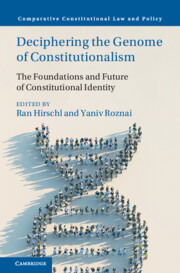Book contents
- Deciphering the Genome of Constitutionalism
- Comparative Constitutional Law and Policy
- Deciphering the Genome of Constitutionalism
- Copyright page
- Contents
- Figures
- Contributors
- Preface
- Acknowledgments
- Introduction
- Part I Foundations, Theory, and Concepts
- Part II Comparative Perspectives
- 8 Confucian Constitutional Identity
- 9 ‘(A-)Religious & Democratic’ Militant Dual Constitutional Identities and the Turn to Illiberalism
- 10 Constitutional Identity in Bangladesh
- 11 Clashing Identities?
- 12 Imposed Revolution?
- 13 India
- Part III American Constitutionalism and Constitutional Identity
- Part IV Emerging Trends
- Index
- References
12 - Imposed Revolution?
“August Revolution,” “Imposed Constitution,” and the Identity of the Constitution of Japan
from Part II - Comparative Perspectives
Published online by Cambridge University Press: 14 March 2024
- Deciphering the Genome of Constitutionalism
- Comparative Constitutional Law and Policy
- Deciphering the Genome of Constitutionalism
- Copyright page
- Contents
- Figures
- Contributors
- Preface
- Acknowledgments
- Introduction
- Part I Foundations, Theory, and Concepts
- Part II Comparative Perspectives
- 8 Confucian Constitutional Identity
- 9 ‘(A-)Religious & Democratic’ Militant Dual Constitutional Identities and the Turn to Illiberalism
- 10 Constitutional Identity in Bangladesh
- 11 Clashing Identities?
- 12 Imposed Revolution?
- 13 India
- Part III American Constitutionalism and Constitutional Identity
- Part IV Emerging Trends
- Index
- References
Summary
The identity of the Japanese Constitution of 1946 is defined by the unusual story of its making process. This constitution was already born with both internal and external disharmony. The new constitution fundamentally changed the former constitution of the Meiji regime; however, it did not replace the former imperial constitution but revised it by using its amendment clause. The continuity between the former and latter regimes was disconnected in a substantive sense but maintained in a procedural sense. This is the internal disharmony. This twisted legal inconsistency can often arise in hard times after losing a war, but it was of grave concern to Japanese legal scholars who tried to justify such legalistic chaos as the “August Revolution.” Nevertheless, it was not the new constitution itself that brought about the revolutionary impact, but the Potsdam Declaration as a condition of surrender imposed by the Allied Forces on the Japanese Government. The Constitution of Japan was not unjustly imposed by the Allied Forces but was legitimately imposed by the Potsdam Declaration, which the Japanese Government itself accepted upon its defeat in the war. More precisely, it is a constitution based on an imposed revolution. This is the external disharmony.
Keywords
- Type
- Chapter
- Information
- Deciphering the Genome of ConstitutionalismThe Foundations and Future of Constitutional Identity, pp. 150 - 162Publisher: Cambridge University PressPrint publication year: 2024



